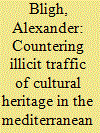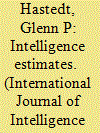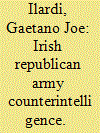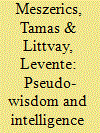|
|
|
Sort Order |
|
|
|
Items / Page
|
|
|
|
|
|
|
| Srl | Item |
| 1 |
ID:
094079


|
|
|
|
|
| Publication |
2010.
|
| Summary/Abstract |
On 5 October 2001, not even a month after the terrorist attacks of 11 September 2001 (9/11), a person died in Boca Raton, Florida, of inhalational anthrax. The low incidence of this disease (only eighteen occupational exposure cases were recorded in the United States during the twentieth century);1 the concern generated after 9/11 regarding possible al-Qaeda attacks using chemical, biological, radiological, or nuclear (CBRN) weapons; and the fact that the etiological agent of this illness is the biological weapon (BW) par excellence, triggered alarms when the cause of this death was made public. Traces of the biological agent were detected a few days later in American Media, Inc. (AMI) facilities, where the deceased worked. Two envelopes, postmarked 18 September, addressed to an NBC reporter and to the editor of the New York Post, both with threatening messages and indicating that they contained anthrax, were retrieved. For a series of reasons, the logical thing to do at that time was to relate these mailings to al-Qaeda. Among those reasons were the proximity in time of the postal mailings with the 9/11 terrorist attacks; the messages included in the envelopes had 9/11 allusions and phrases such as "Death to America," "Death to Israel," and "Allah is great"; and the suspected interest of the 9/11 suicide terrorists in agricultural aircraft to disseminate chemical or biological agents. This is when what is colloquially known as the "Amerithrax"-the name that the Federal Bureau of Investigation (FBI) gave to the criminal investigation-investigation began.
|
|
|
|
|
|
|
|
|
|
|
|
|
|
|
|
| 2 |
ID:
094082


|
|
|
|
|
| Publication |
2010.
|
| Summary/Abstract |
Some of the most thrilling movies of all time depict imaginary or real thefts of artifacts from well-known museums. Topkapi (1964) is about the theft of the Ottoman Sultan's jewel-encrusted dagger from the Istanbul Museum; Entrapment (1999) is about the world's greatest art thief and his plans for the theft of a highly secured piece of artwork. More realistically, most people tend to turn to a news report on art stolen or recovered before they read their usual daily dose of hard news. Art and artifacts definitely capture the collective imagination. Art is usually viewed as the better dimension of human personality, while art thieves often enjoy a degree of infamy not usually associated with other kinds of felonies.
|
|
|
|
|
|
|
|
|
|
|
|
|
|
|
|
| 3 |
ID:
094080


|
|
|
|
|
| Publication |
2010.
|
| Summary/Abstract |
From their earliest days National Intelligence Estimates (NIEs) have had a special, albeit controversial, place in the study of the United States Intelligence Community's analytical products. In its broadest terms, the debate over the significance of NIEs is marked alternately by the Council on Foreign Relations identification of NIEs as the "most authoritative written judgments concerning national security issues,"1 and by the judgment of a panel headed by former Central Intelligence Agency official Richard Kerr-known as the Kerr Group-which concluded in 2004, after looking at intelligence on Iraq, that "historically, with few exceptions, NIEs have not carried great weight in policy deliberations.
|
|
|
|
|
|
|
|
|
|
|
|
|
|
|
|
| 4 |
ID:
094077


|
|
|
|
|
| Publication |
2010.
|
| Summary/Abstract |
The collection of intelligence, whether by the Irish Republican Army (IRA) or the British security forces, became a means and, indeed, an extension of the struggle by which each side sought to assert its dominance and control over the direction and tempo of the Northern Ireland conflict. The implications of this intelligence war were far-reaching, impinging on almost every aspect of the conflict. In addition to its more obvious impact, such as its capacity to determine the outcome of individual operations, intelligence could also influence the conflict in more subtle ways. For instance, the security force's ability to acquire quality intelligence minimized the need to conduct house searches, a practice which proved immensely unpopular among the Nationalist community. From the earliest stages of the Troubles, both sides were engaged in a do or die struggle to control the flow of intelligence. For each, intelligence was crucial to assuring certainty and control for itself, while depriving both from the enemy. For both sides this became the function of counterintelligence.
|
|
|
|
|
|
|
|
|
|
|
|
|
|
|
|
| 5 |
ID:
094078


|
|
|
|
|
| Publication |
2010.
|
| Summary/Abstract |
In 1963, President John F. Kennedy called the President's Foreign Intelligence Advisory Board (PFIAB) the most useful of all of his advisory panels.1 In his first year of office, the Board met more than twice a month on average, more often than in its entire history up to that date. One of its primary tasks under Kennedy was to recommend the reorganization of the many defense intelligence elements.2 The organization of intelligence, the incorporation of technology, the Soviet threat, and political and intelligence scandals have occupied the PFIAB for most of its history. The study of such issues is performed at the direction of the President, and thus reflects his priorities and needs, as well as his opinion of the usefulness of this Board of advisors.
|
|
|
|
|
|
|
|
|
|
|
|
|
|
|
|
| 6 |
ID:
094081


|
|
|
|
|
| Publication |
2010.
|
| Summary/Abstract |
Almost all the strategic surprises that the major powers suffered in the last one hundred years are at least partly attributable to some form of intelligence failure. For the United States the new millennium started with two major failures of this sort: the terrorist attacks of 11 September 2001 and the absence of weapons of mass destruction in Iraq. Naturally, the ever-growing literature in Intelligence Studies treats this topic with special emphasis, at least on a par with other salient issues such as the consumer-producer interface and/or the perennial question of politicization. Despite the widespread attention, no single definition of intelligence failure commands a wide-enough consensus within the discipline or among practitioners. Though obviously related to strategic surprise, whether these should be lumped together with tactical-level shortcomings in intelligence is unclear. Failure can occur at different stages of the intelligence cycle, and distinguishing between these phenomena is probably desirable. However, in the major historical cases, telling apart the otherwise conceptually distinct tasking failure from collection failure, or both from analytic failure and dissemination failure, has proven to be rather difficult. Noting these complications, the focus hence is on analytic failures of a strategic nature.
|
|
|
|
|
|
|
|
|
|
|
|
|
|
|
|
|
|
|
|
|